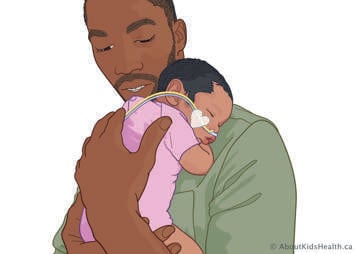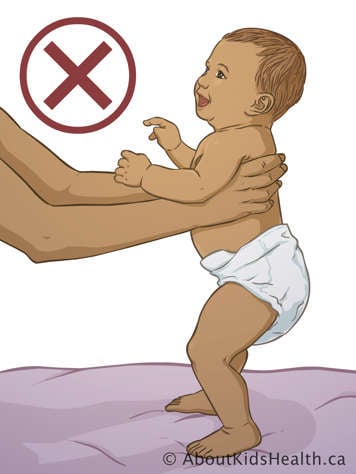Activity recommendations for infants and toddlers after heart surgery
After your infant or toddler has heart surgery, it is important that they stay active, but there are certain positions and activities that you should be careful about. This article outlines recommendations to follow in the days and months, following heart surgery. It includes information on:
- How you can help to position your child after surgery to promote recovery.
- How you can encourage normal development and play while in hospital and at home.
Positioning your child during in-hospital recovery
After heart surgery, it is important that your child be repositioned throughout the day and night to ensure that their lungs stay well expanded and free of mucous. This will also help them to recover their movement. While your child is still in the hospital, they will need to be repositioned every two hours.
When you first reposition your child, it is important to ask your nurse for assistance. The nurse will make you aware of specific precautions related to your child’s status. This will help you to feel more comfortable and ensure that you are following the activity recommendations after surgery.

Lay your child on their side if the incision is on the front of the chest (sternotomy). If their incision is on the side of their ribcage (thoracotomy), avoid lying your child on that side. However, you may lay them on the side without the incision.

Good positions at this time include turning your child onto their side, onto their back, holding them in your arms, and placing them into an infant seat. This will help your child recover sooner so that they can go home.

Placing your child in an infant seat will help to improve their alertness and overall recovery. Your nurse will advise you when it is safe to move to this stage and will help you learn to do this safely post surgery.
As the number of infant seats available in the hospital is limited, we strongly encourage parents to bring their own.
If your child is too big for an infant seat, their physiotherapist or occupational therapist can provide you with a more appropriate seating option.
Normal development and play
Once your child has gone through the initial phases of recovery, and they are able to be more active, parents are encouraged to incorporate age-appropriate activity as part of normal development.
If your child is still in the hospital during this time, bring in a few of your child’s favorite toys to help them feel more comfortable. Toys can include rattles, infant rings, pacifiers/soothers, cause-and-effect toys, blankets, soft toys, etc. Also bring any special feeding equipment your child uses at home (e.g., bottles, nipples, cups).
Regardless of whether you are at home or in hospital, follow the activity restriction guidelines outlined below:
Up to two weeks after surgery
- Avoid tummy time to allow the chest wound to heal.
- Avoid activities that might disturb the wound. After two weeks, lying on the tummy is encouraged for normal development.
Up to six weeks after surgery

- Avoid lifting your child from under their arms. Instead, lift under their bottom and around the back of the shoulders, supporting their head as needed. Avoid pulling your child up by their arms during this period.
- Check with your health-care provider to know whether any other restrictions are in place after surgery.
- Refer to the article After heart surgery: Caring for your child for more details.
Post-sternotomy: Incision at the centre of the chest
Activity guidelines for babies
| Time period | Activity recommendations |
|---|---|
| For the first 2 weeks after surgery | Avoid activities that might disturb the wound. Avoid lying on the tummy. After 2 weeks, lying on the tummy is encouraged for normal development. |
| For the first 6 weeks after surgery | Take care of the chest muscles and bone during all activity. Avoid lifting under the arms. Instead, lift your baby under head/neck and bottom. |
Activity guidelines for toddlers
| Time period | Activity recommendations |
|---|---|
| For the first 2 weeks after surgery | Avoid activities that might disturb the wound. Avoid lying on tummy. |
| For the first 6 weeks after surgery | Take care of the chest muscles and bone during all activity. Avoid lifting toddlers and children under the arms. Instead, lift them under head/neck and bottom. Avoid pushing or pulling heavy objects. Avoid doing push-ups, sit-ups or pulling themselves up on furniture. Avoid backward arm circle movements. Gym class can be resumed but avoid contact sports. |
| Continuing from 6 to 12weeks after surgery | Take care of the chest bone during all activity. Avoid activities that could cause a blow to the chest. These include rough play, ball throwing, football, hockey, karate, or other contact sports. |
Post-thoracotomy: Incision on the side of the chest
Activity guidelines for babies
| Time period | Activity recommendations |
|---|---|
| For the first 2 weeks after surgery | Avoid activities that might disturb the wound such as lying on that side. |
| For the first 6 weeks after surgery | Avoid lifting or pulling your baby on the side with the incision. |
Activity guidelines for toddlers
| Time period | Activity recommendations |
|---|---|
| For the first 2 weeks after surgery | Avoid activities that might disturb the wound such as lying on that side. |
| For the first 6 weeks after surgery | Avoid lifting or pulling on the arm on the side with the incision (i.e., during carrying or dressing). Avoid pushing or pulling heavy objects with the affected arm. Avoid contact sports and rough play. |
If your child needs extra support while in hospital, a therapist may work with them
After your child's procedure, they may have trouble expanding their lungs, or getting rid of mucus on their own. If your child is having trouble, their physiotherapist will need to work with them to help re-expand the lungs and loosen the mucus. Additionally, if they are having issues with feeding, movement, thinking or speech, they may also be seen by the appropriate member of the rehabilitation team.